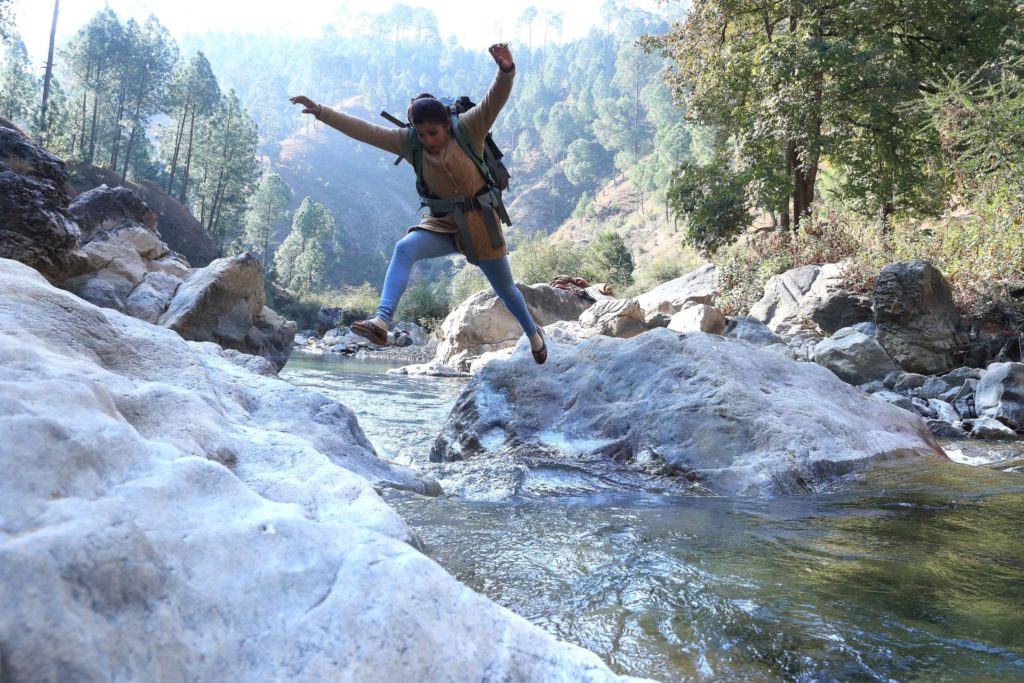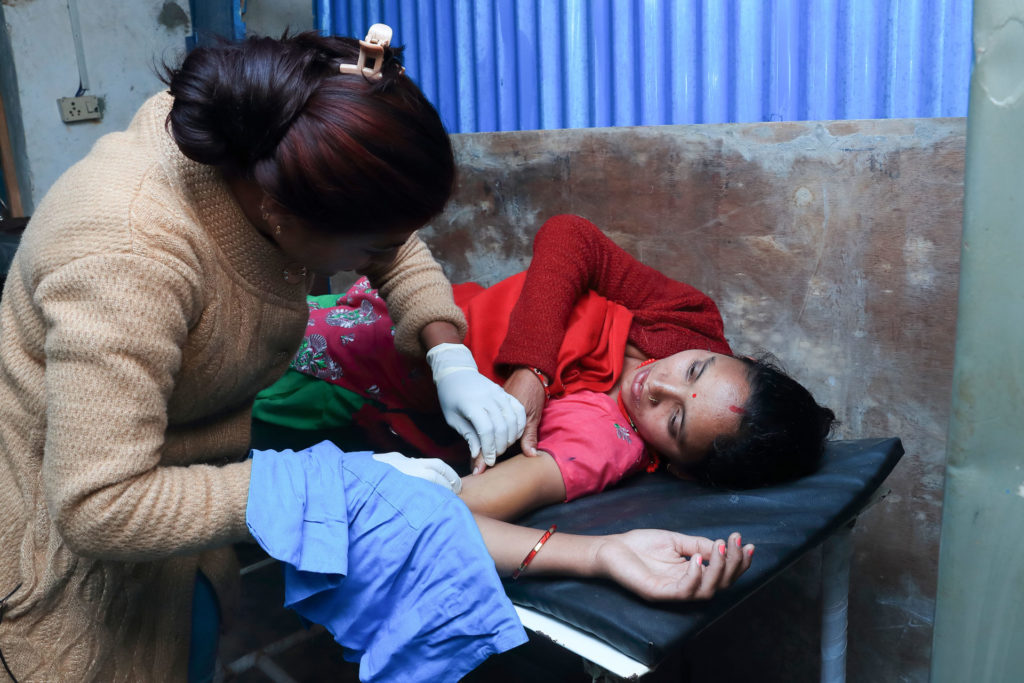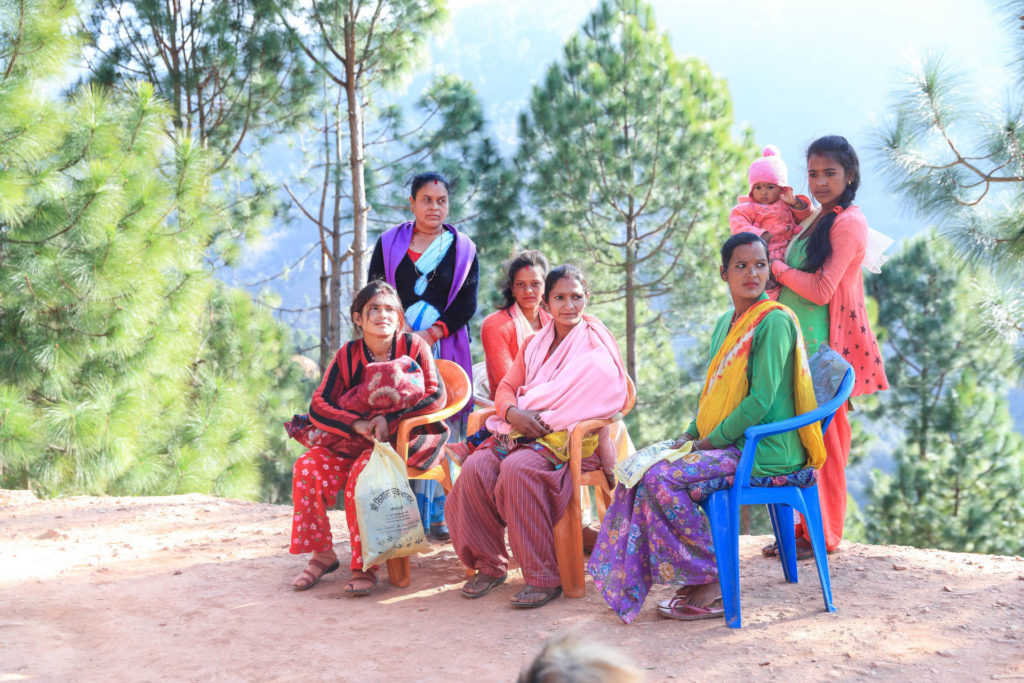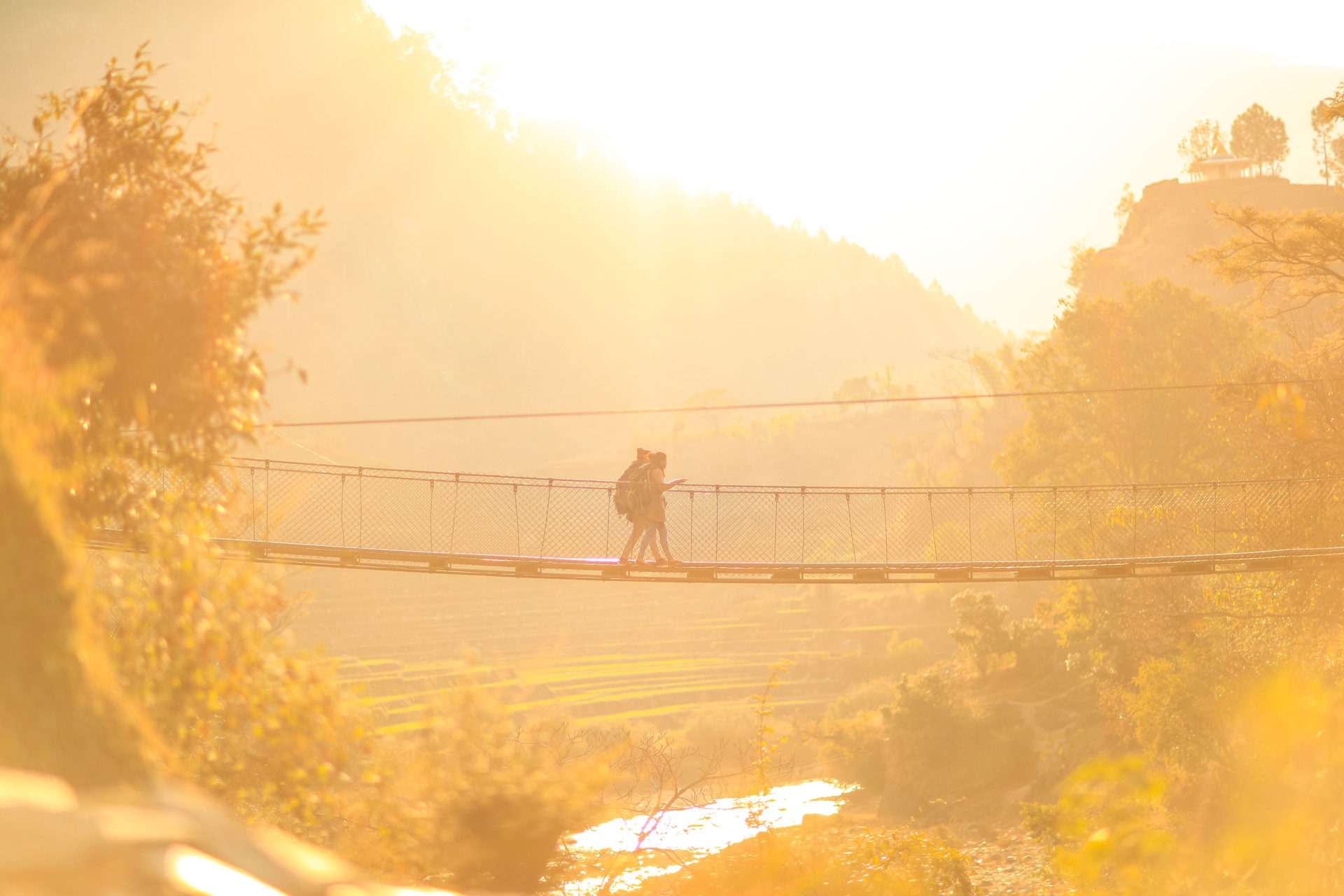The Nepali Women Who Deliver Birth Control by Hiking
Written by Atul Bhattarai | Published: March 2, 2020
Originally published by Outside magazine
One morning last winter in a village in Baitadi, a district in far-west Nepal, Kabita Bhandari sat down with a group of women to dispel local rumors about long-term contraceptives. Bhandari is 22 years old, an auxiliary nurse, a mother of a two-year-old girl, and an employee at the reproductive health agency Marie Stopes International. Earlier that day, she had arrived in Siddhapur from Patan, the capital of Baitadi, which, like the rest of this midhills region of Nepal, has few roads and is notoriously difficult to supply with modern services. As one of its six visiting service providers (VSPs), Bhandari completes a two-week circuit across the district every month, navigating steep, treacherous trails to administer long-term contraceptives to women in far-flung villages. This was her first stop.
Local volunteers had referred the women in Siddhapur to the session. Attendees arranged themselves in a circle outside the village clinic. “We’re all sisters. There’s nothing to be shy about,” Bhandari said. “If you’ve heard anything, ask.” The woman nearest to her, who had walked from a village an hour away, spoke up. Rumors about the intrauterine device (IUD) had been bothering her. She heard that after a heavy day of farm work, squatting in the fields, it might fall out. Worse, there was a chance it would float up and into her stomach and perhaps make its way to her throat. “None of that is true,” Bhandari told her. “People in the villages make things up. It’s a problem.”
Long-term contraception is a novel service for many women in Nepal. In the most remote areas, it’s available in less than 5 percent of government clinics. Although short-term contraceptives—condoms, pills, and injections—are generally stocked, these methods are impractical in a place where many women have to hike for the better part of a day to replenish their supplies. So VSPs promote hormonal implants and copper IUDs as more convenient options: They are cheaper, have fewer side effects, and require no maintenance for years at a time. But it’s one thing to swallow pills, Bhandari told me, and another to agree to have a device inserted under your skin or into your uterus.
Every month, Bhandari and her colleagues fan out from Patan in three groups to reach 68 remote clinics across Baitadi. The outlying ones are about a day’s hike from each other. (The difficulty of the terrain means trips are calculated by time rather than distance.) Once at the destination village, Bhandari administers contraceptives to clients and trains clinic staff, only 12 percent of whom are qualified to insert implants and IUDs.
Perhaps most importantly, she works to gain her clients’ trust. Toward the end of the two-hour session in Siddhapur, a woman in the circle asked if IUDs and implants are completely safe. Bhandari explained that long-term methods have fewer unexpected effects than short-term ones, because they send less medicine into the body, but they cause some women to bleed more heavily or experience intensified menstrual cramps. “They’re like daughters-in-law!” she said. “They have good and bad sides, like everything else.”

The next morning, I set off for a two-hour hike from Patan to Gujar, a village of 3,000 people, with Bhandari and her supervisor, Kalawati Chaudhary, 35. Both women were equipped with 70-liter backpacks containing 50 IUD and implant kits, two sets of surgical equipment, and their personal belongings. Almost immediately, the blacktop gave way to single track. As we walked up some scrubby hills, the path narrowed until it was only a few feet wide, and in an hour we found ourselves at an elevation of 6,000 feet, on a hillside that fell away steeply to Gujar below. Green, terraced hills lay in the distance. We descended, and as we began crossing the freezing Surnaya River, I noticed the women’s footwear. Chaudhary wore ankle-high hiking boots, but Bhandari, in light-wash jeans and an oversize woolen cardigan, had on only a pair of thin-sole Punjabi juttis [embroidered leather flats]. I asked if they were enough to protect her feet from the rugged terrain. “I’m a daughter of the hills,” she said, as she jumped easily between the mossy rocks.
When Marie Stopes hired Bhandari as a VSP in 2017, she was newly certified as an auxiliary nurse-midwife. The reproductive-health-focused United Nations Population Fund (UNFPA) had launched the program only a year before to make long-term contraceptives more accessible in remote Nepal. With funding from the Department for International Development, the UK’s aid agency, the project hired 48 women in 11 of some of Nepal’s poorest districts. They partnered with Marie Stopes in four of them, including in Baitadi. The same year, the project hired Chaudhary, who moved 100 miles—to a locale that was 4,300 feet higher and an eight-hour drive from her home in Dhangadi, a city of 300,000 people in the Terai, the country’s southern lowlands.
Chaudhary was daunted by the new terrain. Nepal’s midhills rise to between 3,000 and 10,000 feet, and although they’re considered a preamble to the snowy peaks of the Himalayas in the north, they’re challenging to navigate. Villages in Baitadi are scattered over an area half the size of Yosemite, linked by steep, rocky trails. The women hike for eight or nine hours at a time, in the winter tramping through snow, in the summer sometimes fording rivers with gear balanced on their heads. Chaudhary has been injured several times on these trips. She once lost her footing on a cliff and tumbled toward the Mahakali River, her fall broken by a slab of rock that was jutting out of the side of the hill. Another time, she and Bhandari found themselves suddenly within charging distance of a pair of wild bulls, one of which went after Chaudhary; she tripped into a bush of thorns while running away, and although she escaped—the bull ran off—the thorns left scars down the right side of her body. (Bhandari, who had darted off in another direction, jokes that the incident taught her “that I loved my own life more than hers.”)

When she took the job, Bhandari, who is from Patan, was excited to explore distant corners of her district. But she was astonished by the bleakness of life she found there. Contraception was an entirely alien service in some villages. “You see women who have six or seven children and are unwillingly having more,” she says. In others the land allows locals to grow only maize and potatoes—and just enough to feed themselves for a few months every year, obliging them to import the rest of their sustenance via pack mule. In places like Dhungad, a village in southeast Baitadi with a population of around 400, there was no food to spare for outsiders when she visited. Bhandari initially brought her then eight-month-old daughter, Kristina, on her trips, because she was unwilling to part with her for weeks at a time. She carried the baby in a sling at her chest. But Bhandari occasionally went hungry at night and was unable to breastfeed, so she began leaving Kristina at home with her grandmother.
Nights can be particularly trying. The women usually arrange to sleep at the homes of female community health volunteers, some 52,000 government-appointed workers across the country who seek out clients for VSP visits. This often means sharing a cramped, smoky room over a barn with a family of six or seven, sleeping around the hearth where dinner is cooked. When they fail to make it to their destination in time, the women have had to request shelter from locals in other villages. They’re frequently turned away: In the country’s conservative far west, many are reluctant to let strangers into their homes out of concern that they might be from a lower caste, Chaudhary says. And they are especially unwilling to host women, who might also be menstruating and therefore impure.
Although they travel in pairs, safety is a constant concern, especially once it gets dark. “You hear about drunk people on the road, about cases of rape,” Bhandari says. “So of course fear plays in your heart.” But she’s learned to rationalize away the risks. “I tell myself I could get injured anywhere, even at home,” she says.
On the trail to Gujar, we encountered a handful of people heading in the opposite direction. We met a local politician in her sixties named Radhika Khadka, who told me she had lived in Kathmandu for a long time and eventually returned to Baitadi. “The wind and water just aren’t the same anywhere else,” she said. We passed by groups of schoolchildren as we neared Gujar and joined a woman plodding up the trail with a bale of hay twice her size on her back. Bhandari inquired about the woman’s home—her husband worked as a laborer in India—then made her pitch. “How many children do you have, sister?” she asked. The woman murmured a reply. “Sister, that must be difficult,” Bhandari said. “Why have so many, right?”
In remote clinics in Baitadi, the staff retention rate is abysmally low. The Siddhapur clinic supervisor told me that staff members who have been trained and promoted tend to request transfers to the Terai, where accessing facilities like schools and hospitals doesn’t demand long hours of hiking. This leaves clinics with unqualified staff and locals with limited access to implants and IUDs, a gap that VSPs have filled for the past two years. When we reached Gujar, we found ten clients waiting for the two women.
Bhandari’s first client for the day was Goma Bista, 26, who had three children, her oldest a ten-year-old son. She had come to receive an implant. Bhandari took Bista through a lineup of contraceptive options. The long-term methods would allow her to plan how many kids she could afford to feed; they are also more convenient. “You can relax for five years,” Bhandari said. She paused. “You might have heard that we cut your arm up to insert the implant,” she added. “We don’t do anything like that.”
As Bista lay on the bed, Bhandari unpacked her bag, removing gloves, Betadine, cotton wool, and gauze. From another pouch, she took out anesthetic and distilled water, as well as a trocar, a syringe-like device to insert the implant rods. A health worker loaded the trocar under her supervision.
“I have an implant, too,” Bhandari reassured Bista, gesturing to her arm. As she asked Bista about her husband and children, Bhandari applied the Betadine and injected anesthetic. She handled the trocar.
A few moments later, Bhandari dressed the area with gauze. “Sister, it’s done,” she said. She guided Bista’s fingers to the two rods in her arm. “Did it hurt?”
“Not at all,” Bista said.
“So what are you going to say in the village?”
“That I couldn’t feel it going in!”

Over the next three hours, Bhandari and Chaudhary tended to the rest of their clients, alternating between counseling the women and performing procedures. In two years, the number of clients in Baitadi has steadily increased, from 598 in 2017 to 989 in 2018. As women discover that others have had successful procedures, Chaudhary says, they seek them out as well. After hearing that a clinic employee in Sakar, a village near Patan, received an implant, 30 local women lined up in a single day—the highest number to date—to do the same.
The sun had begun to set when Bhandari and Chaudhary emerged from the building. “Please call us,” Bhandari told the clinic supervisor as we left. “We’ll come even if only two or four people want the service.”
We started back for Patan, where Bhandari and Chaudhary were scheduled to stay the night before embarking for the farthest villages, Chaukham and Thalakanda, in the east of the district. The previous day, Bhandari told me that the deeper she ventures into Baitadi, the younger her clients tend to be—some are just 17 or 18—and the more children they have. All are married; to seek contraception before then is unthinkable. I asked Bhandari what she advises new brides.
“I say, Take your time, enjoy your marriage,” she said. But many girls face immense pressure: Parents try to get them married off young, and once married, in-laws demand children. I remembered that Bhandari got married when she was 19 and gave birth a year later, so I asked, cautiously, if that had been her experience. “No!” she said. She burst out laughing. “I hadn’t thought about it, I didn’t plan it. I had an accident. That’s why I tell the sisters not to trust condoms!”

